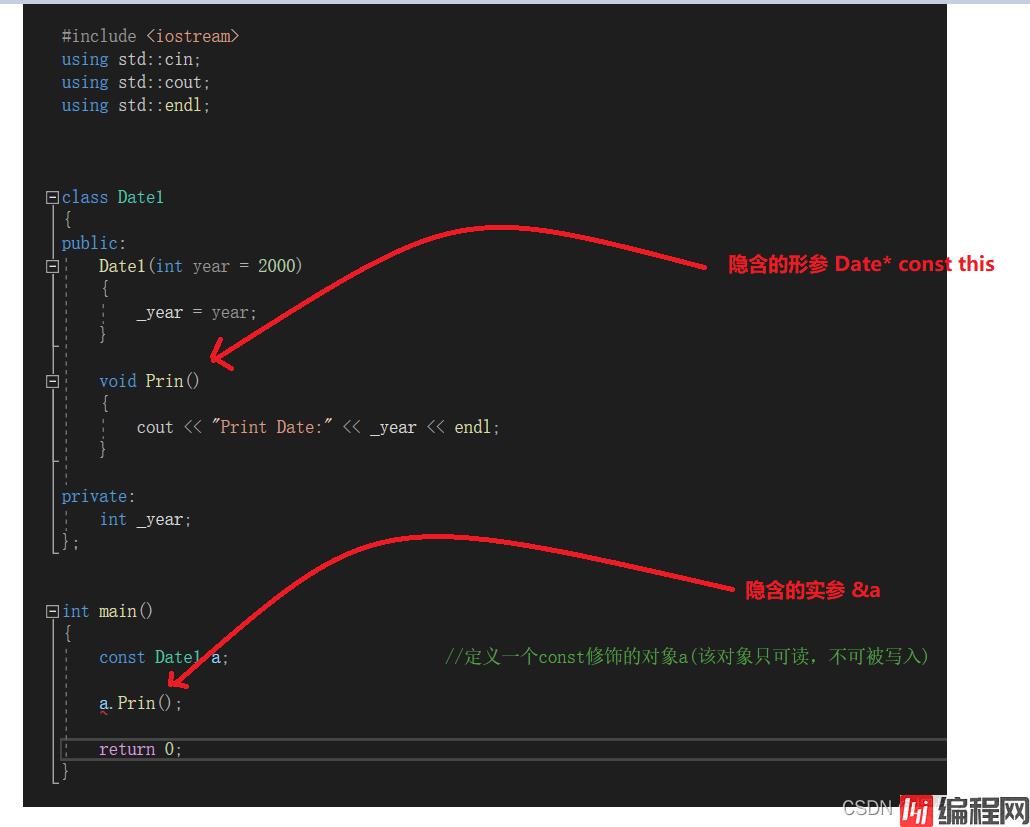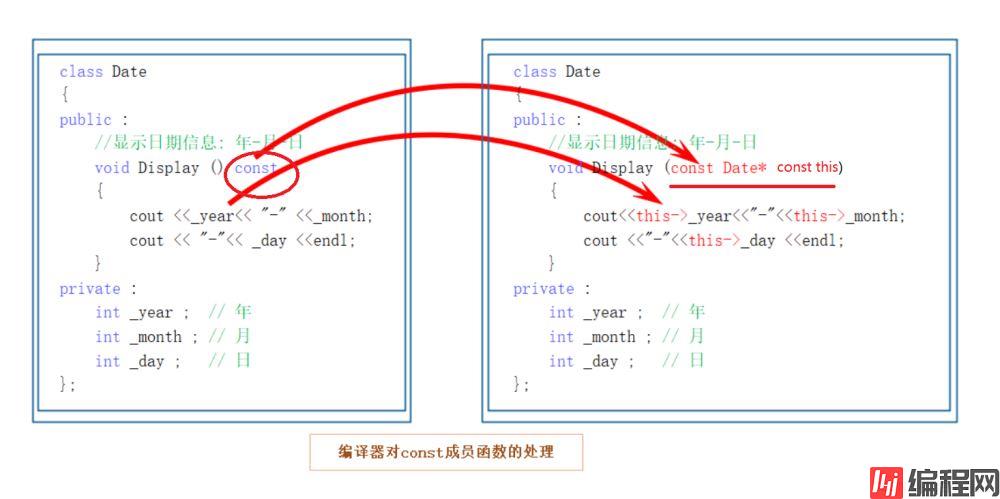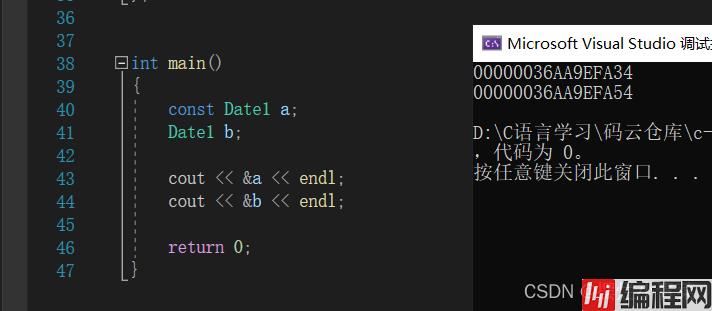目录一.const修饰类的成员函数1.问题引出:2.问题分析3.const修饰类的成员函数 二. 类的两个默认的&运算符重载三. 日期类小练习 总结 一.

给出一段简单的代码
代码段:
#include <iOStream>
using std::cin;
using std::cout;
using std::endl;
class Date1
{
public:
Date1(int year = 2000) 类的全缺省构造函数(可无参调用)
{
_year = year;
}
void Prin()
{
cout << "Print Date:" << _year << endl;
}
private:
int _year;
};
int main()
{
const Date1 a; 定义一个const修饰的对象a(该对象只可读,不可被写入)
a.Prin();
return 0;
}该段程序会编译报错:

上述代码段出错的原因要从类的成员函数的隐含参数this指针出发进行分析:

注意:
我们知道类的每个成员函数都有一个隐含的this指针形参(类型为:类名*const this)。
为了使被const修饰的对象(比如是上面代码段中的a)可以调用其成员对象,c++规定可以用const来修饰类的成员函数。
类中被const修饰的“成员函数”称为const成员函数,const修饰类成员函数,本质上修饰该成员函数隐含的this指针,表明在该成员函数中不能对类的任何成员变量进行修改。(修饰后成员函数的this指针形参类型变为:const 类名* const this)
比如:


const修饰的对象不可以调用非const修饰的成员函数(类指针传参给this指针时读写权限被放大):

非const修饰的对象可以调用const修饰的成员函数(类指针传参给this指针时读写权限被缩小):

const修饰的成员函数内不可以调用其它的非const修饰的成员函数(this指针之间传参时读写权限被放大):

非const修饰的成员函数内可以调用其它的const修饰的成员函数(this指针之间传参时读写权限被缩小):

当类的成员函数中没有对类的成员变量进行任何形式的修改操作时,该成员函数最好都用const来修饰(这样安全同时又使得const修饰的对象可以调用该成员函数)以保证代码的健壮性。

编译器会默认生成两个类的&(取地址)重载用于类的取地址操作(如果我们自定义了类的取地址重载则编译器便不会再生成默认的)
C++中,内置运算符若要直接作用于类对象则必须经过重载。
若想取到类对象的地址,我们可以对&运算符进行重载,比如:
#include <iostream>
using std::cin;
using std::cout;
using std::endl;
class Date1
{
public:
Date1(int year = 2000)
{
_year = year;
}
Date1* operator& () 对&进行重载用于非const修饰的对象的取地址
{
return this;
}
const Date1* operator&() const 对&进行重载用于const修饰的对象的取地址
{
return this;
}
private:
int _year;
};
int main()
{
const Date1 a; 定义一个const修饰的对象a(该对象只可读,不可被写入)
Date1 b;
cout << &a << endl;
cout << &b << endl;
return 0;
}

这两个默认成员函数一般不用重新自定义 ,编译器默认会生成,编译其默认生成的&重载和上面我们自定义的成员函数应该没有什么区别(至少功能上没区别)。
日期类头文件:
为了提高代码的可维护性和可读性,将日期类的成员函数的声明和定义分开写。
#pragma once
#include <iostream>
using std::cout;
using std::cin;
using std::endl;
//记录日期的类
class Date
{
public:
//Date的构造函数
Date(int day=1, int month=1, int year=1);
//获取月份天数的方法
int GetMonthday(const int month) const;
//类对象的日期打印函数
void Print() const;
//判断某个日期是星期几,并打印出来
void GetWeekDay() const ;
//一组比较运算符的重载
bool operator> (const Date& date)const;
bool operator==(const Date& date)const;
//在逻辑上我们只需定义出大于(或小于)和等于的判断函数,剩余的判断函数我们就可以通过复用的方
式简化代码书写
bool operator<(const Date& date)const;
bool operator>=(const Date& date)const;
bool operator<=(const Date& date)const;
bool operator!=(const Date& date)const;
//一组日期+(-)整数的操作和+=(-=)整数的操作
Date operator+(const int day)const;
Date& operator+=(const int day);
Date operator-(const int day)const;
Date& operator-=(const int day);
Date& operator=(const Date& date);
//一组前置++(--)和后置++(--)的重载
Date& operator++(); //实现日期类的前置++
Date operator++(int); //实现日期类的后置++
Date& operator--(); //实现日期类的前置--
Date operator--(int); //实现日期类的后置--
//实现时期相减的操作符重载
int operator-(const Date& date)const;
private:
int _day;
int _month;
int _year;
};日期类的成员函数的实现:
#include "Date.h"
//Date的构造函数
Date ::Date(int day, int month, int year)
{
_day = day;
_month = month;
_year = year;
if (_year <= 0 || _month <= 0 || _month > 12 || _day <= 0 || _day > GetMonthday(_month))
{
cout << "date invalued please exit the app" << endl;
exit(0);
}
}
//获取相应月份天数的方法
int Date::GetMonthday(const int month)const
{
static const int arr[12] = { 31,28,31,30,31,30,31,31,30,31,30,31 };
int ret = arr[month - 1];
if (((0 == _year % 4 && 0 != _year % 100) || (0 == _year % 400)) && 2 == month)
{
ret++;
}
return ret;
}
//类对象的日期打印函数
void Date::Print()const
{
cout << _year << ' ' << _month << ' ' << _day << ' ' << endl;
}
//判断某个日期是星期几,并打印出来
//注意this指针不能由用户去传
void Date::GetWeekDay()const
{
const char* arr[7] = { "星期一","星期二","星期三","星期四","星期五","星期六","星期日" };
const Date tem(1, 1, 1900);
const int subret = (*this)-tem;
printf("%s\n", arr[(subret % 7)]);
}
//将 > 运算符进行重载
bool Date ::operator> (const Date& date)const
{
if (_year > date._year)
{
return true;
}
else if (_year == date._year && _month > date._month)
{
return true;
}
else if (_year == date._year && _month == date._month && _day > date._day)
{
return true;
}
return false;
}
//将 =运算符进行重载
bool Date:: operator==(const Date& date)const
{
if (date._day == _day && date._month == _month && date._year == _year)
{
return true;
}
return false;
}
//在逻辑上我们只需定义出大于(或小于)和等于的判断函数,剩余的判断函数我们就可以通过复用的方式简化代码书写
bool Date :: operator>= (const Date& date)const
{
if ((*this) > date || (*this) == date)
{
return true;
}
return false;
}
bool Date :: operator < (const Date& date)const
{
if ((*this) >= date)
{
return false;
}
return true;
}
bool Date :: operator<=(const Date& date)const
{
if ((*this) > date)
{
return false;
}
return true;
}
bool Date:: operator!= (const Date& date)const
{
if ((*this) == date)
{
return false;
}
return true;
}
//一组日期+(-)整数的操作和+=(-=)整数的操作
Date& Date::operator+=(const int day)
{
if (day < 0)
{
(*this) -= (-day);
return (*this);
}
_day += day;
while (_day > GetMonthday(_month))
{
if (_month < 12)
{
_day -= GetMonthday(_month);
_month++;
}
else
{
_day -= GetMonthday(_month);
_year++;
_month = 1;
}
}
return (*this);
}
Date Date::operator+(const int day)const
{
Date tem(*this);
tem += day;
return tem;
}
Date& Date::operator-=(const int day)
{
if (day < 0)
{
(*this) += (-day);
return (*this);
}
_day -= day;
while (_day <= 0 )
{
if (_month > 1)
{
_month--;
_day += GetMonthday(_month);
}
else
{
_year--;
_month = 12;
_day += GetMonthday(_month);
}
}
if (_year <= 0)
{
cout << "operation invalued" << endl;
exit(0);
}
return (*this);
}
Date Date::operator-(int day)const
{
Date tem(*this);
tem -= (day);
return tem;
}
Date& Date ::operator=(const Date& date)
{
if (this != &date)
{
_day = date._day;
_month = date._month;
_year = date._year;
}
return (*this);
}
//一组前置++(--)和后置++(--)的重载
Date& Date ::operator++() //实现日期类的前置++
{
(*this) += 1;
return (*this);
}
Date Date ::operator++(int) //实现日期类的后置++
{
Date tem(*this);
(*this) += 1;
return tem;
}
Date& Date:: operator--() //实现日期类的前置--
{
(*this) -= 1;
return (*this);
}
Date Date:: operator--(int) //实现日期类的后置--
{
Date tem(*this);
(*this) -= 1;
return tem;
}
//实现时期相减的操作符重载
int Date::operator-(const Date& date)const
{
int count = 0;
Date min;
if ((*this) < date)
{
min = (*this);
while (min != date)
{
min++;
count++;
}
return -count;
}
else
{
min = date;
while (min != (*this))
{
min++;
count++;
}
return count;
}
}到此这篇关于C++类中const修饰的成员函数及日期类小练习的文章就介绍到这了,更多相关C++类const修饰的成员函数内容请搜索编程网以前的文章或继续浏览下面的相关文章希望大家以后多多支持编程网!
--结束END--
本文标题: C++类中const修饰的成员函数及日期类小练习
本文链接: https://lsjlt.com/news/178559.html(转载时请注明来源链接)
有问题或投稿请发送至: 邮箱/279061341@qq.com QQ/279061341
2024-03-01
2024-03-01
2024-02-29
2024-02-29
2024-02-29
2024-02-29
2024-02-29
2024-02-29
2024-02-29
2024-02-29
回答
回答
回答
回答
回答
回答
回答
回答
回答
回答
0